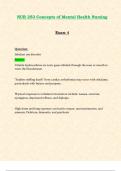NUR 253 Concepts of Mental Health Nursing Exam 4 Question: Inhalant use disorder Answer: Volatile hydrocarbons are toxic gases inhaled through the nose or mouth to enter the bloo dstream. "Sudden sniffing death" from cardiac arrhythmias may occur with inhalants, particularly with butane and propane. Physical responses to inhalant intoxication include: nausea, anorexia, nystagmus, depressed reflexes, and diplopia. High doses a nd long exposure can lead to stupor, unconsciousness, and amnesia. Delirium, dementia, and psychosis Question: Treatment for Inhalants Answer: usually does not require any treatment. - Serious and potentially fatal responses such as: coma, cardiac arrhythmias, or bronchospasm do happen. - This self -limiting (a few hours to a few weeks) problem may require careful use of haloperidol (Haldol) to manage severe agitation. Question: Withdrawal from Inhalants Answer: SXS: sweating, tachycardia, insomnia, N/V, tremors, agitation, seizure, and hallucinations Question: Opioid intoxication Answer: People intoxicated on opioids exhibit psychomotor retardation, drowsiness, slurred speech, alt ered mood, and impaired memory and attention. They also exhibit pupillary constriction. Intense drowsiness can lead to a coma. Question: Opioid Withdrawal Answer: - Morphine, heroin, and methadone withdrawal syndrome begins 6 to 8 hours after the last do se following a period of at least a week of use. - Meperidine (Demerol) withdrawal begins within 8 to 12 hours from abstinence and lasts about 5 days. Question: Opioid overdose Answer: Death attributable to opioids usually stems from respiratory arrest due to the respiratory depressant effect of the drug. Symptoms of overdose include: unresponsiveness, slow respiration, coma, hypothermia, hypotension, and bradycardia. **Three symptoms —coma, pinpoint pupils, and respiratory depression —are strongly suggestive of overdose.**




